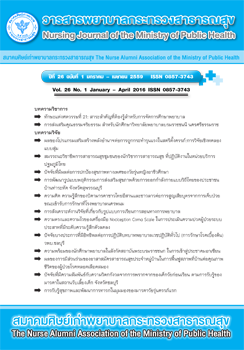The Effects of Village Health Volunteers’ Participation to Home Health Care Model on Quality of Life in Stroke Patients
Main Article Content
Abstract
This was a quasi-experimental research which aimed to study 1) the effects of Village Health Volunteers’ participation in a Home Health Care Model on the Quality of life of stroke patients. 2) satisfactions of Village Health Volunteers, patients and their care givers with the participation in Home Health Care. The sample groups included 1) 30 village health volunteers recruited by the multi-stage random sampling method, 2) 30 stroke patients receiving home care from the volunteers, and 3) 30 main caregivers. Samples were grouped into a 15-members of experimental group and a 15-members of control group in Suphanburi province. Applied research instruments consisted of two parts, namely 1) a data collection Instrument, including a) personal data questionnaire, b) ADL assessment form, c) Quality of life measurement form, and d) the satisfaction of the Village Health Volunteers semi-structural interview form; 2) the experimental instrument was the Village Health Volunteers’ participant Model used for rehabilitation at Home Health Care Service. Data analysis methods included distribution, percentage, chi-square, mean, standard deviation, t-test and content analysis.
The results showed that mean score of the Quality of Life of the experimental group was statistically significant higher than that of the control group (p<.05). The results from interviews found that the Village Health volunteers who received training were satisfied to participate in Home Health Care rehabilitation. Moreover, patients and caregivers who participated in this study were satisfied with the rehabilitation service. The findings suggest that the model should be used to guide the care for stroke patients at home.
Article Details
บทความและรายงานวิจัยในวารสารพยาบาลกระทรวงสาธารณสุข เป็นความคิดเห็นของ ผู้เขียน มิใช่ของคณะผู้จัดทำ และมิใช่ความรับผิดชอบของสมาคมศิษย์เก่าพยาบาลกระทรวงสาธารณสุข ซึ่งสามารถนำไปอ้างอิงได้
References
2. กระทรวงสาธารณสุข. สำนักโรคไม่ติดต่อ.รายงานประจำปี 2552. กรุงเทพฯ : สำนักงานกิจการโรงพิมพ์องค์การสงเคราะห์ทหารผ่านศึกในพระบรมราชูปถัมภ์; 2554.
3. นิพนธ์ พวงวรินทร์ และ อดุลย์ วิริยเวชกุล.Acute stroke management. ในนิพนธ์ พวงวรินทร์(บรรณาธิการ).โรคหลอดเลือดสมอง.พิมพ์ครั้งที่ 2. กรุงเทพมหานคร: เรือนแก้วการพิมพ์; 2544.
4. สถาบันประสาทวิทยา. แนวทางการพยาบาล ผู้ป่วยโรคหลอดเลือดสมองสำหรับพยาบาลทั่วไป. กรมการแพทย์ กระทรวงสาธารณสุข; 2552.
5. Padilla, G. V., & Grant, M. Quality of life as a cancer nursing outcome variable. Advances in Nursing Science. 1985; 8(1);45-60.
6. กรมสนับสนุนบริการสุขภาพ.คู่มือ อสม. ยุคใหม่. กรุงเทพฯ: ชุมนุมสหกรณ์การเกษตรแห่งประเทศไทย ; 2554.
7. จารึก ธานีรัตน์.ผลของการวางแผนจำหน่ายต่อความสามารถของผู้ดูแลผู้ป่วยโรคหลอดเลือดสมอง. [วิทยานิพนธ์พยาบาลศาสตร์มหาบัณฑิต].สงขลา มหาวิทยาลัยสงขลา นครินทร์; 2545.
8. วีณา ลิ้มสกุล.ผลของโปรแกรมการสนับสนุนของครอบครัวต่อการปรับตัวของผู้สูงอายุโรคหลอดเลือดสมอง.[วิทยานิพนธ์พยาบาลศาสตร์มหาบัณฑิต].เชียงใหม่:มหาวิทยาลัยเชียงใหม่;2545.
9. ปิ่นนเรศ กาศอุดม.คุณภาพชีวิตของครอบครัวที่มีผู้สูงอายุป่วยเรื้อรัง.วารสารการศึกษาและการพัฒนาสังคม, 2549; 2(1); 9-20.
10. นิภาภัทร ภัทรพงศ์บัณฑิต, ทิพาพร วงศ์หงส์กุลและพวงพะยอม ปัญญา.ผลของการพยาบาลระบบสนับสนุนและให้ความรู้ต่อความ สามารถในการดูแลผู้ป่วยโรคหลอดเลือดสมอง.พยาบาลสาร, 2550; 14(1),121-30.
11. ภรภัทร อิ่มโอฐ นงพิมล นิมิต อานันท์ สุพัฒนาคำสอน และจารุวรรณ เหมะธร.ปัจจัยที่มีอิทธิพลต่อพฤติกรรมการดูแลที่บ้านของญาติผู้ดูแลผู้ป่วยโรคหลอดเลือดสมอง.วารสารมหาวิทยาลัยคริสเตียน, 2552; 15(2);140-1.
12. สำนักงานนโยบายและแผน สาธารณสุขจังหวัดสุพรรณบุรี.สถิติสาธารณสุข ปี 2554. สำเนาอัดเอกสาร; 2554.
13. บรรณฑวรรณ หิรัญเคราะห์, ทวีลักษณ์ วรรณฤทธิ์ และพวงพะยอม ปัญญา.ผลของการฟื้นฟูสภาพที่บ้านต่อคุณภาพชีวิตของผู้ป่วยโรคหลอดเลือดสมอง.พยาบาลสาร, 2550; 34(1); 110-20.
14. เฟื่องฟ้า สีสวย และพวงสร้อย วรกุล.คุณภาพชีวิตของผู้ดูแลผู้ป่วยโรคหลอดเลือดสมองโรงพยาบาลจุฬาลงกรณ์. จุฬาลงกรณ์เวชสาร,2551; 52 (ฉบับพิเศษ); 15-28.
